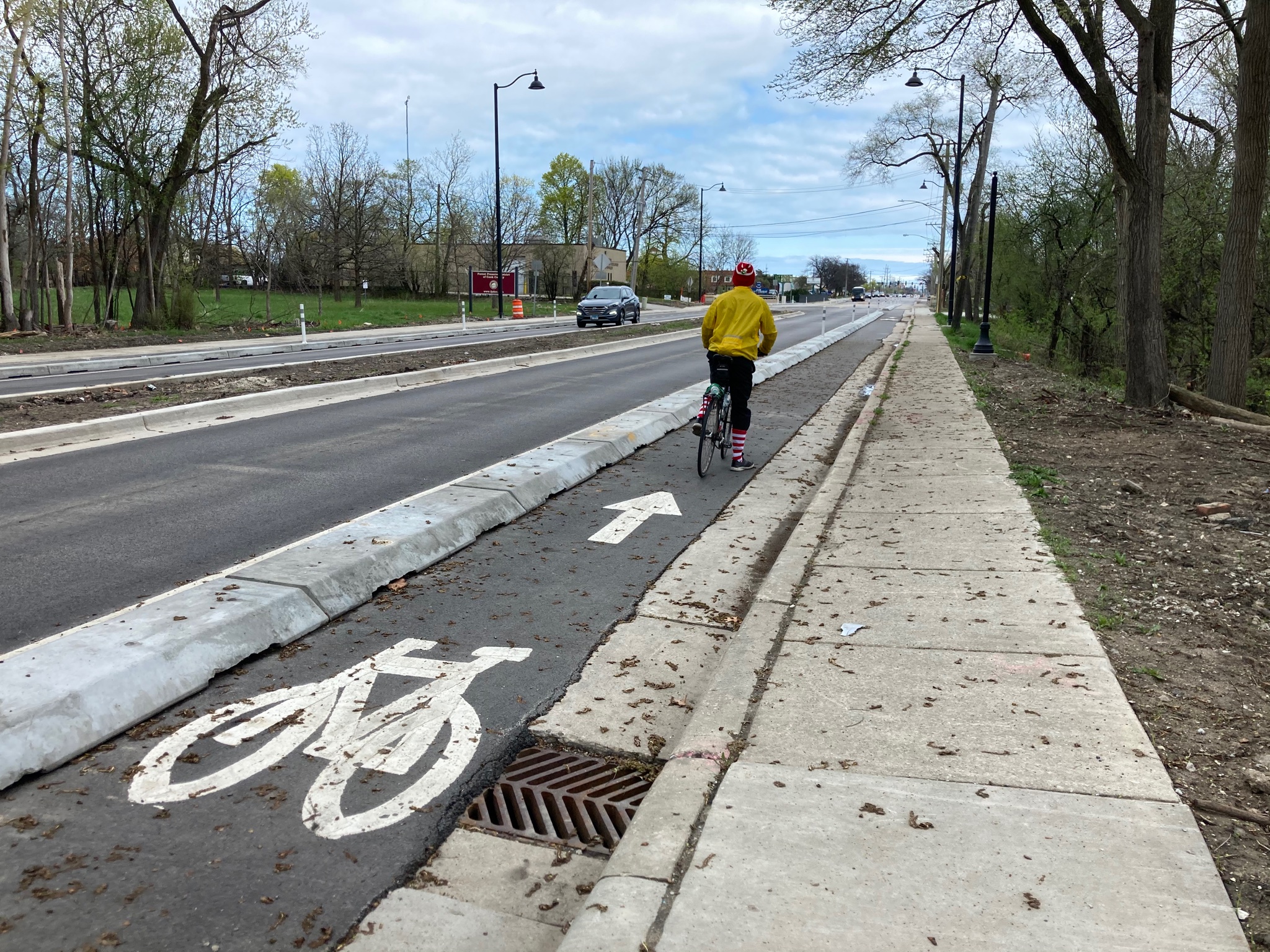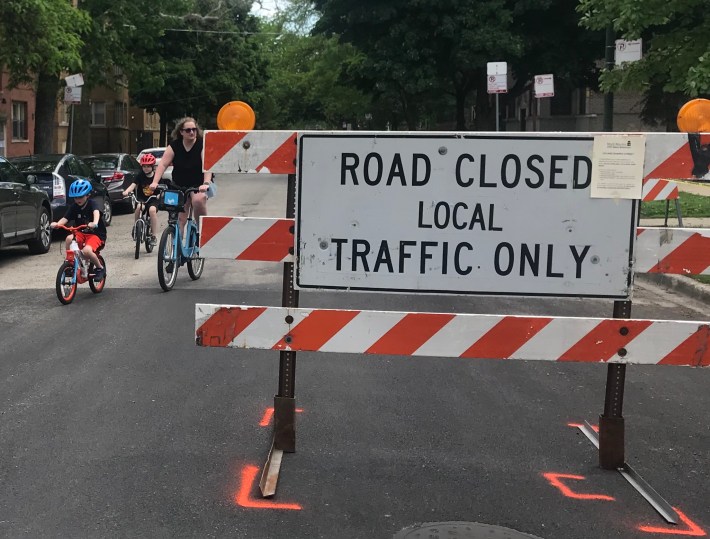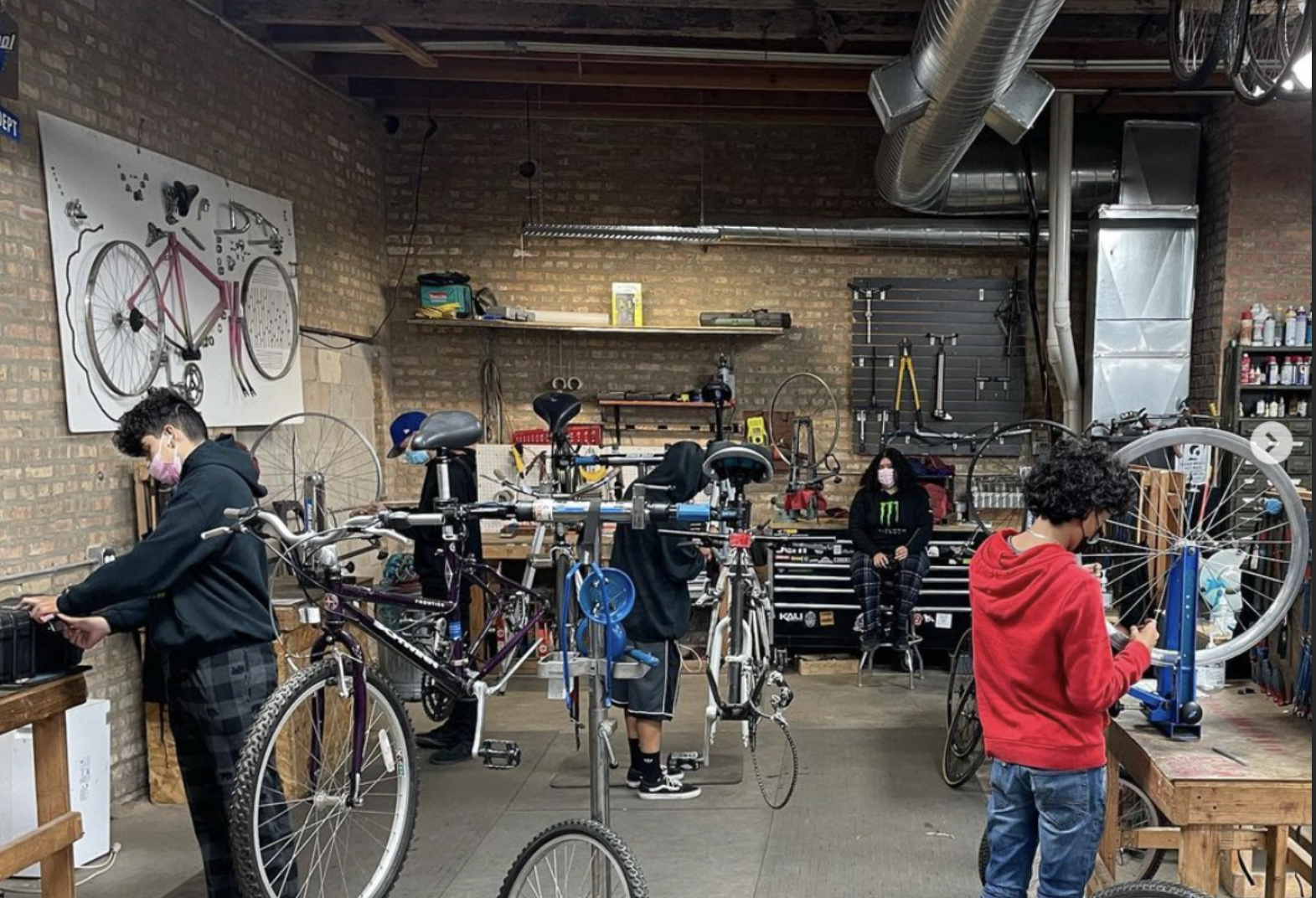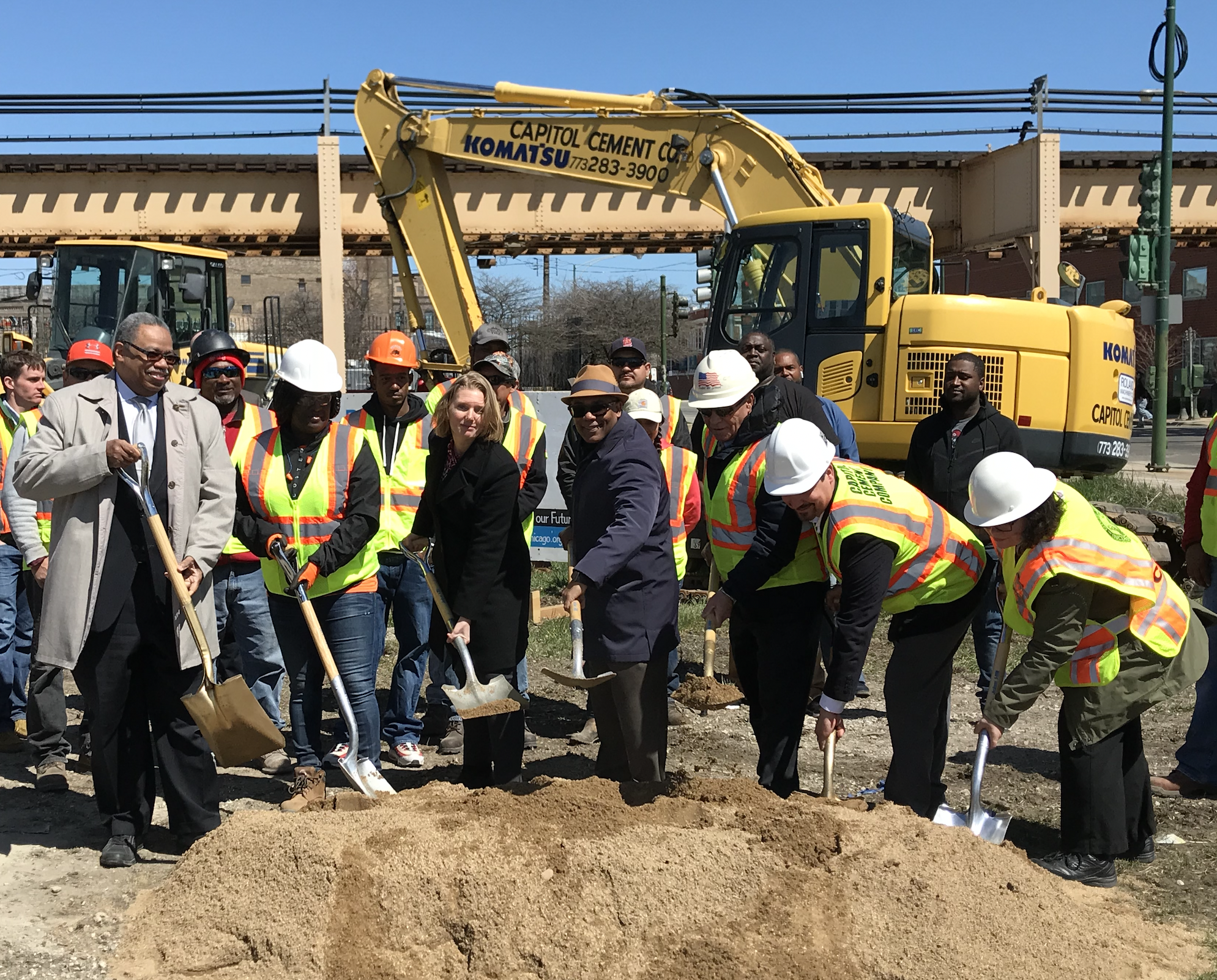What political realities must we overcome to create a protected bike lane network?
6:21 PM CDT on July 6, 2021

A concrete curb-protected bike lane recently installed on Howard Street near the North Branch Trail. Photo: John Greenfield
The Active Transportation Alliance recently held a discussion on what it will take to create more safe bike infrastructure in Chicago. Aldermen Daniel LaSpata (1st), Andre Vasquez (40th), and Matt Martin (47th) were featured speakers.
LaSpata began by saying he supports ATA’s work and that the vast majority of his trips are made on bike or on foot. He then contextualized the call for a protected bike lane network. “[Investing in complete streets] means turning the prioritization of our public way, essentially, on its head.”
LaSpata highlighted tweaks to improve bus service in his ward such as the Western and Chicago rush hour bus lanes. He discussed ATA’s bus report card campaign and the “D” grade the 1st ward received. LaSpata also talked about the protected bike lanes on Milwaukee Avenue in a portion of his ward. Given a recent crash along that stretch in which an SUV knocked over some of the plastic bollards, it’s clear that flexible posts are insufficient for keeping cars out of bike lanes.
Hope nobody was hurt, but let’s use concrete bollards next time. This photo shows how useless flexiposts are… @AldermanLaSpata @nzettelplanning @ChicagoDOT pic.twitter.com/kKi3t42Hff
— Milwaukee Ave Bike Lane (@MilwaukeeAvBike) June 30, 2021
LaSpata also discussed the need for better maintenance of Chicago’s protected bike lanes. “We don’t want to give any fuel to those skeptics who believe that bike lanes are aesthetically poor in their community.”
Lastly, LaSpata pointed out the need to improve the intersection of Logan and Western avenues, where drivers fatally struck Tyler Fabeck, 22, in 2008 and Kevin Clark, 32, on May 26 of this year. He said CDOT is putting together a plan for near-term safety improvements that LaSpata and his team will review. The upgrades are expected to be completed by the end of summer. The alderman added there’s reasons to be hopeful more changes will be made in the future, given the $20 million fund for Vision Zero projects from the city’s capital plan, and the prospect of more money for bike and transit infrastructure if President Biden’s federal infrastructure bill is passed.
Alderman Vasquez said he recognizes the need to improve and increase the city’s biking infrastructure. He argued that building bikeways hinges on three things: identifying a stretch of road where bike infrastructure can fit, funding, and political support. Vasquez stated that the 40th ward doesn’t have a large number of wide roads to accommodate bike lanes.
However, roads don't necessarily need to be wide to accommodate bike lanes. There are plenty of streets in Chicago where bikeways could be added if we had the political will to remove some of the curbside parking for it. Granted, that's often complicated by Chicago's terrible parking meter contract, which requires the city to compensate the concessionaire for lost revenue, but the city has handled that problem on streets like Milwaukee Avenue in River West by creating new diagonal metered spots on side streets.
It’s disappointing that even aldermen who are fairly progressive on sustainable transportation issues see removing car storage as a political non-starter, even as the impact from climate change and traffic congestion continues to worsen.
However, Vasquez gets points for pointing out that Slow Streets (the city calls them "Shared Streets"), traffic-calmed side streets where through traffic is banned to enable safe walking and biking, could lead to permanent infrastructure improvements. The alderman also encouraged sustainable transportation advocates to support new parking-lite developments given that they often face a backlash from neighbors who fear they'll create an on-street parking crunch.

I disagree that it's up to sustainable transportation advocates to win over their neighbors when it comes to protected bike lanes, bus lanes, and parking-lite developments. These things are all pretty basic requirements for any city that’s serious about climate action and improving livability.
I am aware of the political risks alders sometimes face whenever constituents fear driving will become a little less convenient. But any good leader should be able to get most of their constituents on board with smart initiatives. They should be upfront about what’s at stake: a livable planet, public health, and a non-gridlocked transportation system.
But in addition to Vasquez's discussion of Slow Streets, I appreciated that he said he wants to increase funding for sidewalk repairs and improvements and establish a floor for pedestrian and cycling infrastructure funding, such as a percentage year over year indexed to the need, as opposed to a set amount of funds over a number of years.
Alderman Martin talked about a number of upcoming projects in the 47th ward. New non-protected bike lanes are planned along Montrose Avenue between Damen Avenue and Clark Street. A contraflow bike lane is slated for the one-way eastbound stretch of Sunnyside Avenue between Lincoln and Western avenues, including a bike signal at Western. And protected bike lanes are being constructed on Roscoe and Campbell avenues connecting Belmont and Western avenues. Martin also mentioned a “partially protected bike lane” on Clark St. between Irving Park Rd and Montrose coming sometime this year.

During the Q & A, alders were asked how we can achieve a protected bike lane network when aldermen have the power to veto such projects. Martin noted that aldermanic privilege – the de-facto power of Council members to veto projects in their wards – and a ward-by-ward approach impacts many issues our city faces. He highlighted the importance of electing people who recognize the need to tackle issues in a multi-ward manner and who have sustainable transportation at the top of their agenda.
While aldermanic privilege can be harmful, Martin noted that aldermen often have a good sense of what's happening in their communities on a micro-level. They can also elevate their ward’s needs to city departments that otherwise may not see issues as being urgent.
Vasquez added that in order to achieve a citywide bikeway network “the decision-making should be centralized.” He would prefer to see the mayor's office lead the city departments in the same direction on this. He contrasted New York’s network of open streets vs Chicago’s approach to Slow Streets. “If an alder wants to try it, we can install one.” Vasquez also noted that when the mayor takes the lead, it takes the pressure off aldermen.
LaSpata noted that discussions like this are helpful in educating the public about what is happening in City Council and the challenges aldermen face. Additionally, there’s a need to educate alders and the public on what infrastructure can look like. He pointed out that many alders don’t know what Vision Zero (the city's goal of eliminating all serious and fatal traffic crashes) or Complete Streets mean.
I agree with LaSpata in that there is a need to educate and even inspire the public as to how our streets can function. Currently there is no grand vision for Chicago’s bike infrastructure. Sure, there is the Chicago Streets for Cycling Plan 2020 but I’m skeptical of how inclusive and representative the public input process was that led to its creation. In addition, any good cycling plan should inspire current drivers to get out of their cars. Currently, there is no such inspiring or visionary plan to increase bike or transit mode share in Chicago.
ATA staffer W. Robert Schultz III said he’d like to know what message alders had for drivers when it comes to the benefits of investing in walk/bike/transit. Martin replied, “I think about it in the context of the institution we serve in and the individual people we talk with who need to be convinced.” On an institutional level, he thinks people can be swayed by the opportunity for Chicago to be a leader in this area, that is, “We are the first city to do X” or “We’re among the top cities for X.” He also believes that people can be influenced by the environmental and safety angle.
Another audience member asked the aldermen how advocates can sway other Council members who are less bike-friendly than they are. When it comes to individual aldermen, Martin encouraged folks to listen to the concerns the alder is raising such as the budget, equity, or the potential impact on businesses. Vasquez added that it’s not a matter of an alder being bike friendly or not, but rather it’s more a matter of alders listening to their constituents. “The self interest of any elected official is to remain in office.” Vasquez encouraged advocates to conduct outreach to neighbors.
Based on this conversation, it seems there are three paths that could achieve an all-ages-and-abilities protected bike lane network in Chicago: a strong visionary mayor who funds and empowers the transportation department to create the network; electing more alders who have a progressive transportation platform; or smart organizing from sustainable transportation advocates that changes hearts and minds in all 50 of Chicago’s wards.
The latter is the slowest, potentially draining way of going about it. I personally resent that non-professional cycling advocates are being asked to continue with the unpaid labor of convincing a driving majority that they deserve infrastructure that will prevent injury or death.
Stay in touch
Sign up for our free newsletter
More from Streetsblog Chicago
Communities United: Reports of Bikes N’ Roses’ death have been greatly exaggerated
According to the nonprofit shop's parent organization, BNR has paused its retail component, but is still doing after school programming and looking for new staff.
Pressure is mounting to replace embattled CTA President Dorval Carter
Here's a look at what elected officials and other media outlets have said about the issue recently.
Service boost means BNSF Line will get Metra’s first-ever across-the-board weekend schedule, starting April 29
In addition, Halsted Street station will get weekend service, and Downers Grove's Fairview stop will become an off-peak stop.



